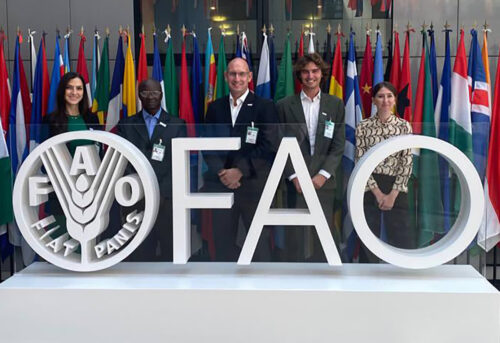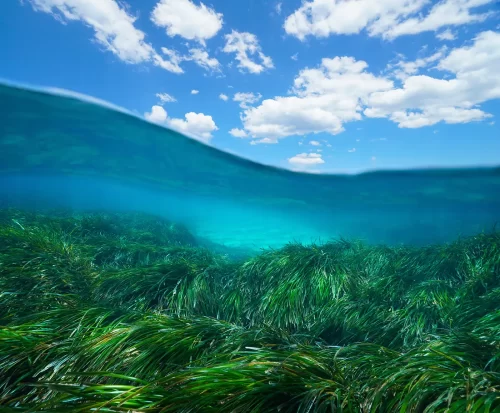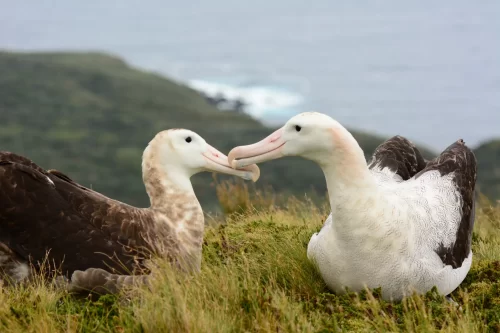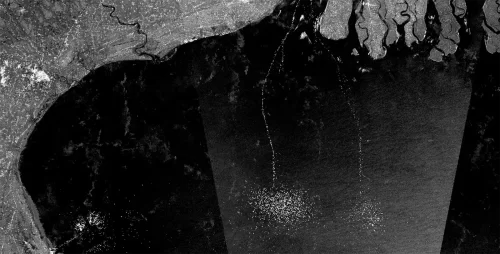Committee on fisheries advances transshipment monitoring, vessel identification and tracking to fight illegal fishing

International fisheries are managed through a patchwork of regulations, which present loopholes that are often exploited for financial gain, undermining collective good governance efforts.
To help address this, every two years, the Committee on Fisheries (COFI) of the Food and Agriculture Organization of the United Nations (FAO) convenes to review the status of the world’s fisheries and make formal recommendations to help improve the management and sustainability of global fish stocks. Earlier this month, the 35th Session of COFI was held in Rome, allowing Members of the Committee to come together to agree on priorities and make calls-for-action in support of ocean stewardship.

A small delegation from Global Fishing Watch attended the meeting—the organization’s first as official observers. A recentsurge in data sharing agreements from the likes of Norway, Benin and the Republic of the Marshall Islands, coupled with the emergence of an IUU Fishing Action Alliance—a political pledge that outlines a series of actions that need to be taken now to end illegal, unreported and unregulated (IUU) fishing—has piqued global interest around the concept of fisheries transparency.
Following COFI34 where Latin America made strong declarations in support of sharing vessel data, expectations were high when it came to potential new actions that the committee would take to support fair and effective fisheries governance.
Transparency to enhance fisheries management
From combating illegal fishing to reforming transshipment, the concept of transparency can help bolster action around some of the major commitments made at this year’s COFI meeting.
Flag States are primarily responsible for the monitoring and control of their vessels, regardless of where their fleets operate. However, accountability falls to coastal and port States when it comes to ensuring vessels comply with fisheries measures, including those that enter their respective waters and ports. This approach does not take into consideration the limited resources many coastal and port States have, nor does it reinforce the need for flag States to control their vessels.
To break this cycle, governance must center on decisive, data-driven action. But flag States don’t always have the information needed to monitor their distant water fleets or vessels engaged in at-sea transshipments—and coastal and port States often lack access to vessel data that can help ensure their actions are successful. So while data sharing mechanisms exist in principle, in practice they are not working as intended.
Transparency offers a cost-effective and scalable way to ensure that all decision makers have access to the information they need to govern our ocean. It helps support regional and international coordination, aligns efforts between coastal, port and flag States, and also increases the level of accountability of vessel behavior.
Global Fishing Watch urges FAO Members to adopt a transparent approach in tackling the issues identified at COFI35.
Implement global transshipment guidelines
Transshipment, or the transfer of catch between vessels, plays an integral role in the global commercial fishing industry. Large refrigerated cargo vessels, or carriers, take on catch at sea allowing fishers to avoid costly and time-consuming trips back to port to unload their haul. But transshipment often takes place far out at sea, beyond the sight and reach of authorities, presenting challenges in effective monitoring and controls.
Current oversight of at-sea transshipment is far from adequate, with a high percentage of transfers neither reported nor observed. This lack of transparency creates gaps in management which open the door for illegal activity to take place, as well as the misreporting or nonreporting of catch.
In 2020, the 34th Session of COFI called for the development of international transshipment guidelines—a significant step toward the reform of transshipment practices. After a two-year process made up of robust technical and expert consultations and input from multiple stakeholders, the Committee endorsed the new guidelines and, while voluntary, encouraged all Members and regional associated bodies to adopt, implement and improve transshipment oversight and management practices. These guidelines were developed through a comprehensive, inclusive and thoughtful process and will support improved fisheries management and help prevent IUU-caught fish from entering the supply chain.
As FAO Members States work to implement these guidelines nationally and regionally, they should require greater transparency of vessel authorization, tracking and transshipment event data to support guideline implementation.
Develop a vessel tracking agreement
IUU fishing is one of the greatest threats to marine ecosystems as it has the potential to undermine national and regional efforts to sustainably manage fisheries. Central to the capacity to tackle IUU fishing is the ability to monitor and understand a vessel’s behavior. This goes far beyond a vessel’s mere identity—it means knowing what a vessel is authorized to do and where it has been operating. To do this at scale would be a game-changer.
Transparency champion Norway—the newest country to share its vessel tracking data with Global Fishing Watch—proposed the first-ever global tracking agreement for vessels during COFI 35. With significant support from the Committee, the FAO will now convene a technical workshop that will consider the scope of such an instrument—type, size, areas of operation for eligible vessels—existing regional requirements on vessel tracking, available and emerging technologies, mechanisms for noncompliance, data sharing methods, and ensured equity across all States regardless of their resources. FAO Members have an opportunity to recommend the instrument be binding in nature, allowing verification that each vessel is operating where and how it is permitted to do so, and also enabling coastal and port States to adequately manage their waters and maximize their monitoring, control and surveillance efforts.
This process should consider how transparency of vessel tracking information can enable dynamic and data-driven action to address IUU fishing.
Make data accessible
Identifying vessels and linking their identification to records, registers and other fishery information is essential in tackling IUU fishing. But to be useful, data such as this must first be accessible. Transparency—the publication of vessel information—will increase accessibility and create knowledge that will reach the widest possible audience.
Recent advances in satellite technology and machine learning have the potential to illuminate human activity at sea and revolutionize how we manage the marine environment. These systems can provide a wealth of data that can support traditional monitoring, control and surveillance of fisheries. Global Fishing Watch seeks to create and publicly share knowledge about the ocean through the creation of map visualizations and data and analysis tools.
The international community also recognizes the benefits of publicly available vessel identification and authorization information.
The Committee highlighted the importance of information sharing, transparency and traceability in combating IUU fishing and Members encouraged further adoption of transparency initiatives including the FAO Global Record, the Global Information Exchange System and the IUU Fishing Action Alliance. Members also referenced the role of public vessel tracking data and collaboration to improve fisheries management and address IUU fishing.
The sharing of additional information on transshipment events, vessel tracking and beneficial ownership will ensure that stakeholders have access to data that provides them with a comprehensive picture of vessel behavior, enabling them to advance ocean governance and take targeted and informed actions when necessary.
Transparency in support of ocean governance
Transparency of information is not a silver bullet when it comes to ending IUU fishing, but it goes a long way in bolstering sound fisheries management. A healthy and resilient ocean relies on transparency for fair and effective governance where sustainability can be achieved.
The publication and sharing of key vessel information can enable stakeholders to work together and ensure every political, technical and operational decision maker has access to the latest data needed to make informed and dynamic choices, ultimately preventing IUU operators from exploiting knowledge and governance gaps.
The global community cannot let action stagnate between now and the next Session of COFI that will take place in Rome in 2024. A new subcommittee on fisheries management—established by the Committee and made up of FAO members, regional bodies and civil society groups—will need accessible, dynamic and transparent data to inform its technical and policy-based discussions. To make a true impact, FAO Member States must adopt a transparent approach to ocean governance that includes the publication and accessibility of authorization information as well as vessel tracking and transshipment event data.
Courtney Farthing is the international policy director at Global Fishing Watch.


